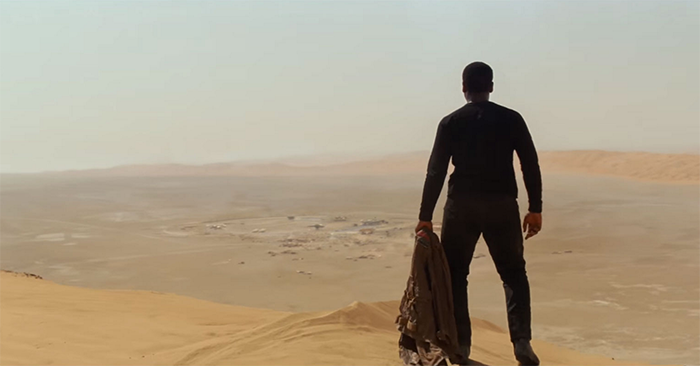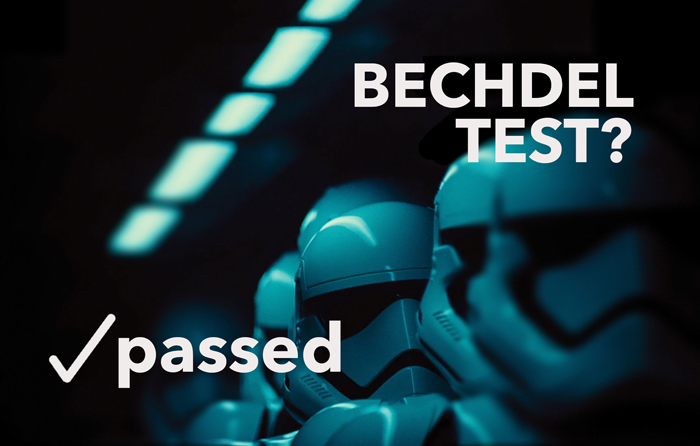Here’s an uncomfortable question: Prior to seeing Star Wars The Force Awakens last weekend did you know that the movie was co-lead by a woman and a person of color?
Really, I mean that. Would you have said: YES, this movie is about a newly discovered female Jedi (maybe!?) and a defecting Stormtrooper, who also turns out to be a person of color?

I am guessing you would have said no. In many ways, this movie was pitched as an ensemble cast, meant to misdirect your attention all the way down to the posters. There’s a reason Finn is wielding a lightsaber and Rey is positioned alongside Kylo Ren. Even in re-watching all the trailers, it becomes clear that this is a movie full of feel-good cameos and a cast of new characters, most prominently scored to feature the adorable BB-8. And I have a sneaking suspicion all of this was by design.
By now, there are have been countless blog posts about the importance of having the biggest movie of all time be led by Daisy Ridley and John Boyega. And make no mistake: THIS IS A VICTORY. This is a victory for audiences. This is a victory for creating more equity in Hollywood. This is a victory for established brands. As more Star Wars movies are developed with this cast, it will continue to be an important marker of progress. And dammit, that’s exciting.
But here’s a really uncomfortable fact we must face as audiences and consumers: why did the franchise fail to embrace the diversity of its cast in the marketing and promotion of the film?
Let’s look at this dynamic in the wake of another important announcement about a beloved franchise: Noma Dumezweni was cast as the grown-up Hermione Granger in the London play “Harry Potter and the Cursed Child” this week. And she is not white. Blessed be the dead body of dear Dumbledore, some people were not very happy about that. Right or wrong, this reactive audience uproar is very much what we could have faced if JJ Abrams and company had announced their true motives or even given a clear picture of who the actual star of the new movie was early on in the promotional circuit. It’s critical that we examine our own biases and ask: Would audiences have had as much of an open mind? Would there have been countless haters starting campaigns to boycott the film as we have seen in the days following the Hermione announcement?
May I be so bold as to suggest that we live in a time of two types of audiences?
The Tale of Audience One: Those who would have embraced a movie co-lead by a woman and a person of color and even heralded it publicly and boldly.
The Tale of Audience Two: Those would have been turned off by the notion of a non-white dude led iteration of their beloved franchise.
And you know what sucks? The film was marketed and promoted to abate the fears of the Audience Two at the cost of truly embracing what Audience One wants and is right to celebrate. There’s a reason we didn’t see Rey and Finn action figures in all the Christmas shopping holiday marketing this year - which really doesn’t make a damn bit of sense once you’ve seen the movie. Meanwhile, we have been bombarded with BB-8 toys for the last 3 months. And whether or not we want to admit it, we live in a time when this is a deliberate and strategic choice. By withholding the identities of the real heroes, the film didn’t have to take on the heat of fans who should be forced to face their own internal sexism and racism and could gracefully collect the biggest box office earnings ever in the history of film.
And yet, this trickles beyond the marketing. Our leads were reportedly the lowest paid on the film too, which isn’t uncommon, but their reported salaries are much lower than newcomer white dudes in similarly iconic franchises. For example, the Fifty Shades of Grey co-stars reportedly earned double those low-six figure sums reported for Boyega and Ridley.
What sucks the most is that I don’t blame them. The Catch-22 of this situation is mind-numbing: if they had heralded Rey and Finn early, would it have succeeded anyway? I want to believe that it would have. But now we will never know. As a fan and as a woman whose life is dedicated to this issue, I have to almost sit back and applaud them for playing it the way they did and resent them at the same time. It was masterful and manipulative and brilliant.
Here’s the silver lining: There’s no hiding now. We all know that Rey is it. She’s the one. She is who carries the franchise forward. And I am willing to bet that by the time Episode 8 hits theaters, we will have analyzed her character in academic and non-academic settings to the point where it’s almost painful. But at the very least, when everyone sells out all those damn theaters again, they’ll know exactly who they’re going to see.
The big news of the internets over the last 24 hours? Star Wars The Force Awakens reportedly passes the Bechdel Test. And this is good news. I’ve already reported why I’m optimistic about the new film thanks to the certified, informal Shonda Rhimes “Hell Yes” stamp of approval. But I also think that it’s not enough for all of us to accept this and move on. And here’s why.

Star Wars The Force Awakens will be the biggest film of the year. It may be the biggest film of the decade. Perhaps the century. Seriously. I mean that.
Let’s quickly be reminded what the Bechdel Test actually is because I’m shocked how few people know the details. It starts with cartoonist named Alison Bechdel. In 1985, she penned a strip called “The Rule” in her series, Dykes To Watch Out For. The test requires a movie to:
- Have more than one woman in the film
- The women must talk to each other
- And the women must talk about something other than a man
It’s not a perfect test. But for 30 years, it’s provided a frame of reference that women, and really anyone, who care about the value that women provide in media and the value of our stories as a whole. Roughly 55% of films passed the test last year, which is pretty damn impressive, but it’s basically pathetic when you realize that the in 1955, 56% of major feature films passed the test.
Tough to get excited when you see those numbers, isn’t it?
And so this is why I’m going to push you to think about this: Is Star Wars passing the Bechdel Test really the only criterion we should be requiring the biggest motion picture of our recent history to be judged against when it comes to how it treats women and people of color?
I would say no. I would say, we should both HOPE for and DEMAND more. There are plenty of reasons to be hopeful, too. Shonda Rhimes doesn’t just stand for female empowerment: she IS female empowerment in Hollywood. Star Wars star Gwendolyn Christie reported that her costume wasn’t a prototypical sex pot piece, which is promising. And the most recent trailers heavily feature Daisy, one of the new characters to be added to the franchise. Not only is she featured, she is in on the action and part of it too.
This weekend, as we all head to the theaters to see our beloved franchise reimagined by the mind of JJ Abrams, I hope we’ll all go in with higher expectations. It’s no longer enough for franchises to tokenize women and people of color. It’s no longer acceptable for “strong female characters” to be sexualized props and scantily clad for the sake of visual aesthetics at the expense of story logic. And it should no longer be acceptable to cast one person of color and think we’ve hit our quota.
I’m excited because The Force Awakens could be a new day - not just in the Star Wars universe - but in how inclusion our entertainment can be.
Truth: I wasn’t excited about the new Star Wars movie. No trailer could get me jazzed. No BB8 toy. No new apparel. Even the awesome cast couldn’t get me pumped. I attribute this to two things: 1. I feel like the movie has overtaken the new culture for the last few years and it hasn’t even been seen, which feels like a lot of hype for an unknown entity. 2. I don’t totally trust JJ Abrams with female characters. Sorry, JJ.
But then, Shonda Rhimes proudly introduced the new movie clips as part of her tour with her book Year of Yes. On top of that, the film released a new TV spot last week during the Thank God It’s Thursday lineup on ABC that seemed to heavily rely on the story of Daisy, the primary female character we’ve been introduced to in previous trailers and teasers. For those that don’t know, TGIT is the night where Shonda Rhimes’ properties take over the television and nothing else matters but women kicking ass and being represented.
So what does it all mean?
Here’s a theory: this film may be more about Daisy than any other character. And in fact, this is a female led Star Wars movie. And in fact, it’s also a movie with a second lead that’s a person of color.
If that’s the case, then hell yeah, I can get excited. Real excited. Not only would it mean that we are officially living in an era where major properties are putting non-white dudes in the lead, but it means an long-established property with record-breaking presales are going to be pushing that exact narrative. Of course, I have no problem with that. No problem at all.